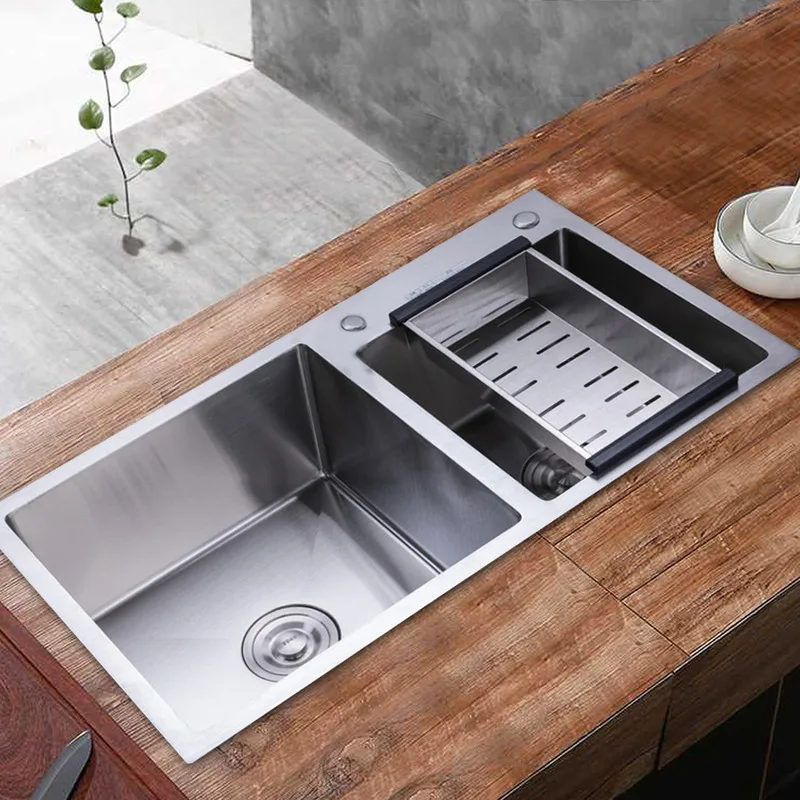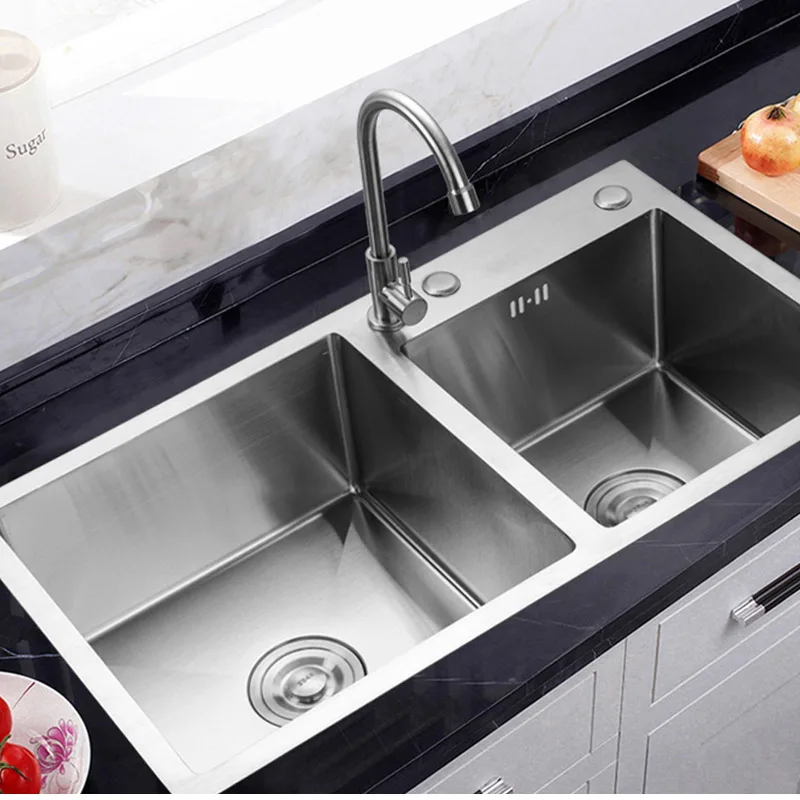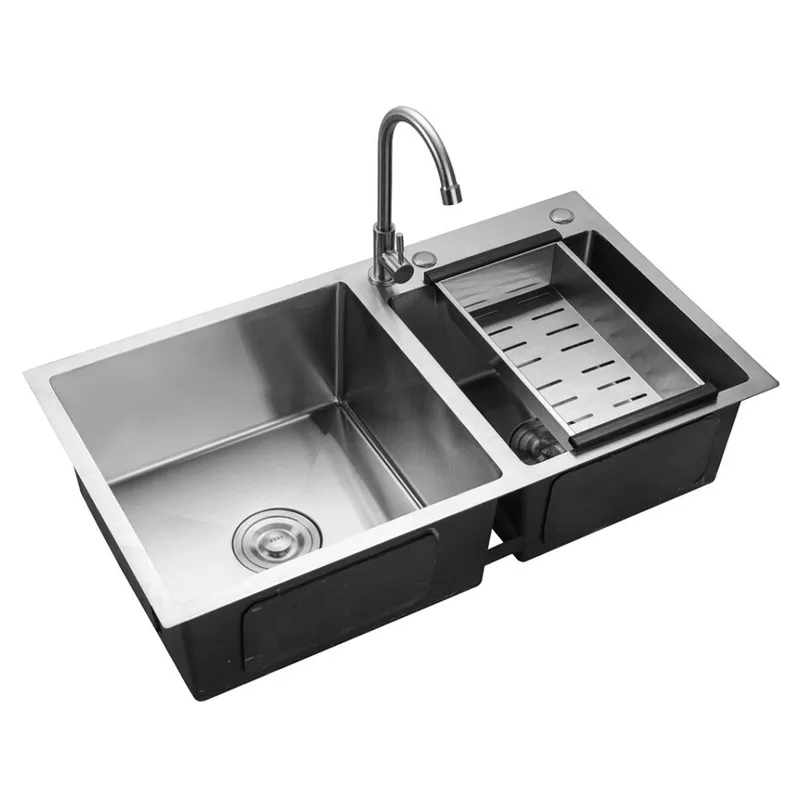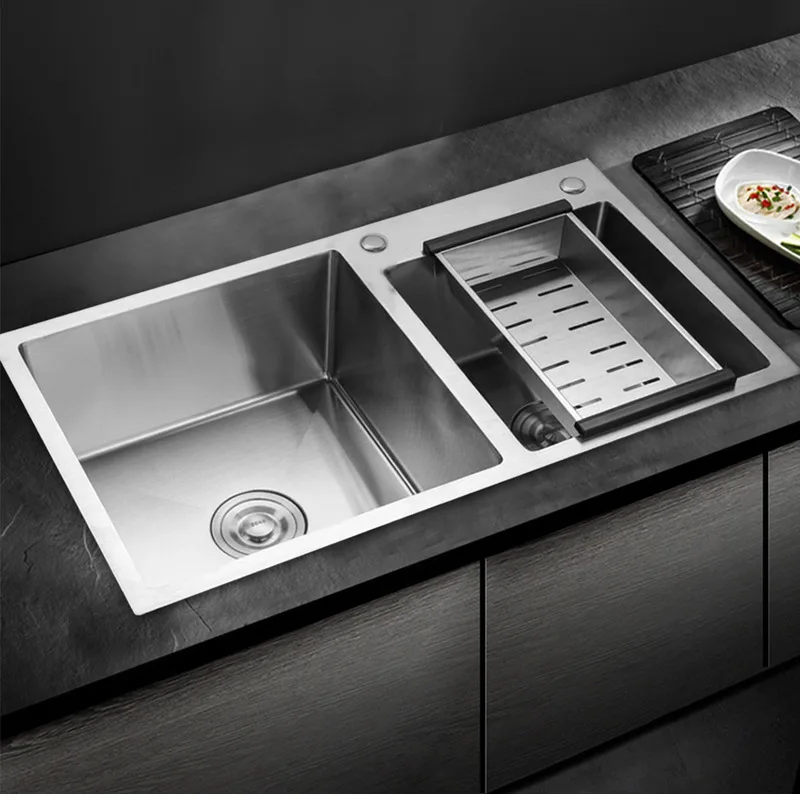Pre-Cleaning Preparation
Before diving into the cleaning process, it’s essential to be well-prepared.
Gather Necessary Cleaning Supplies
Start by collecting all the supplies you’ll need to clean your stainless steel kitchen sink effectively. This includes:
- Baking soda for gentle scrubbing
- White vinegar for stains and disinfection
- Olive or mineral oil for polishing
- A soft cloth, sponge, or non-abrasive scrubber for cleaning
- A microfiber cloth for drying and buffing
- Protective gloves to keep your hands safe
Clear the Sink and Remove Debris
Next, make sure that your sink is free from any items or debris. Here’s how:
- Remove dishes, utensils, and any other objects from the sink.
- Dispose of food scraps and other waste to prevent blockages.
- Wipe down the surface to eliminate any loose dirt or crumbs.
With these preparations complete, you’re ready to start the cleaning process for a shiny stainless steel kitchen sink.

Initial Cleaning Process
The journey to a pristine sink begins with a thorough initial cleaning.
Rinse with Hot Water and Dish Soap
Start by filling the sink with steaming hot water. Add a few squirts of dish soap. Let the hot soapy water sit for a few minutes to loosen grime. After that, release the water and rinse the sink walls with hot water, ensuring no soap suds remain.
Scrub Gently with a Soft Cloth or Sponge
Next, take a soft cloth or non-abrasive sponge dampened with the hot water mix. Gently scrub the sink’s surface. Focus on areas with noticeable food particles or stains. Go easy on the scrub to prevent scratches on the stainless steel. Rinse again with hot water to wash away any lingering grime or soap.
Addressing Tough Stains and Discoloration
When your stainless steel kitchen sink has tough spots, baking soda and vinegar can help.
Apply Baking Soda Paste
Create a paste by mixing some water with baking soda. Apply the paste to the stains. Use a soft cloth to rub it gently. This will avoid scratching the surface. Let it sit for a few minutes. Then, rinse it off with warm water.
Baking soda acts as a mild abrasive. It helps to lift off stubborn stains without harming the sink’s finish.
Use Vinegar Solution for Hard Water Stains
Mix equal parts of white vinegar and water for hard water stains. Apply it with a soft cloth. Focus on discolored areas. Vinegar’s acidity breaks down hard water deposits. After a few minutes, rinse the sink well. Dry it with a microfiber cloth to prevent new spots.
These steps will tackle stains and keep your stainless steel sink looking new.
Polishing and Restoring Shine
A polished sink makes your kitchen shine. Here’s how to do it.
Rinse Thoroughly and Dry with a Microfiber Cloth
After cleaning, rinse your sink thoroughly. Use warm water to remove any cleaner residue. Then, take a microfiber cloth and dry the sink completely. This step prevents water spots, which can dull the sink’s shine.
Buff with Olive or Mineral Oil for Extra Shine
For added luster, use some olive or mineral oil. Put a few drops on a soft cloth. Rub it over the sink surface in circular motions. The oil acts as a polish and creates a protective barrier. It gives your stainless steel kitchen sink a beautiful, lasting shine.
Maintenance and Regular Upkeep
To keep your stainless steel kitchen sink in top condition, regular maintenance is key.
Routine Cleaning After Use
After each use, give your sink a quick clean to prevent buildup and stains. Here’s what you should do:
- Rinse the sink with water to remove any food particles or residue.
- Wipe the sink with a soft cloth or sponge, using a bit of dish soap if needed.
- Dry the sink with a microfiber cloth to avoid water spots and maintain shine.
Tips for Avoiding Scratches and Damage
Preventing damage is easier than fixing it. Protect your sink with these simple tips:
- Use a gentle touch when cleaning; avoid abrasive sponges or steel wool.
- Place a protective mat or grid at the bottom of the sink when washing heavy pots.
- Keep sharp objects away from the sink surface to prevent scratches.
- Don’t leave acidic foods or harsh cleaners on the sink for long periods.
Regular attention will help preserve the sparkle and integrity of your stainless steel kitchen sink.

Troubleshooting Common Issues
When maintaining your stainless steel kitchen sink, you may encounter rust and stubborn stains or unwanted odors. Here’s how to address these common issues efficiently.
Safe Removal of Rust and Stubborn Stains
Occasionally, rust can appear on stainless steel sinks. This is how to remove it safely:
- Mix equal parts of baking soda and lemon juice to form a paste.
- Apply the paste to rust spots using a soft brush or cloth.
- Gently scrub the spots until the rust lifts away.
- Rinse the sink with water and dry immediately with a microfiber cloth.
For other stubborn stains like tea or coffee marks:
- Make a paste of baking soda and water.
- Apply it to the stain and let it sit for a few minutes.
- Scrub gently with a soft cloth or sponge.
- Rinse and dry with a microfiber cloth for a clean finish.
Deodorizing and Neutralizing Odors
Kitchen sinks can develop unpleasant odors over time. To freshen up your sink:
- Pour a mixture of one part white vinegar and four parts water down the drain.
- Let it sit for an hour; then rinse with hot water.
- For daily freshness, sprinkle baking soda in the sink and rinse after a few minutes.
With these tips, your stainless steel kitchen sink will not only be gleaming but also hygienic and odor-free.
Preventing Future Rust and Stains
To keep your stainless steel sink looking pristine, prevention is key. Here are some strategies to avoid rust and stains:
Regular Cleaning Routine
Establish a regular cleaning routine to prevent buildup. Wipe down the sink with a gentle dish soap and a soft sponge after each use. This not only removes food particles but also helps prevent stains from setting in.
Use the Right Cleaning Tools
Avoid using steel wool or abrasive cleaners, as they can scratch the surface of stainless steel and lead to rust formation. Instead, opt for soft cloths or non-abrasive sponges for cleaning.
Dry After Use
Always dry your sink thoroughly after washing dishes or using water. Standing water can cause stains and rust over time, so a quick wipe with a microfiber cloth can make a significant difference.
Tackling Hard Water Deposits
If you live in an area with hard water, mineral deposits can accumulate in your sink, leading to unsightly spots. Here’s how to tackle them:
Vinegar Solution
Create a solution of equal parts vinegar and water. Soak a cloth in the mixture and lay it over the affected areas. Let it sit for about 15 minutes to loosen the deposits, then scrub gently and rinse.
Softening Water
Consider installing a water softener if hard water is a persistent issue. This will not only benefit your sink but also extend the life of your plumbing and appliances.

Handling Scratches and Damage
Over time, your sink may develop scratches. Here’s how to address them effectively:
Polishing with Baking Soda
For light scratches, sprinkle baking soda over the area and use a damp cloth to gently rub it in. This can help blend the scratch with the surrounding surface.
Professional Repair for Deep Scratches
If the scratches are deep, consider consulting a professional for repair. They have specialized tools and techniques to restore your sink’s finish without causing further damage.
By following these maintenance tips, you can keep your stainless steel kitchen sink in excellent condition, ensuring it remains a functional and beautiful part of your kitchen for years to come.
